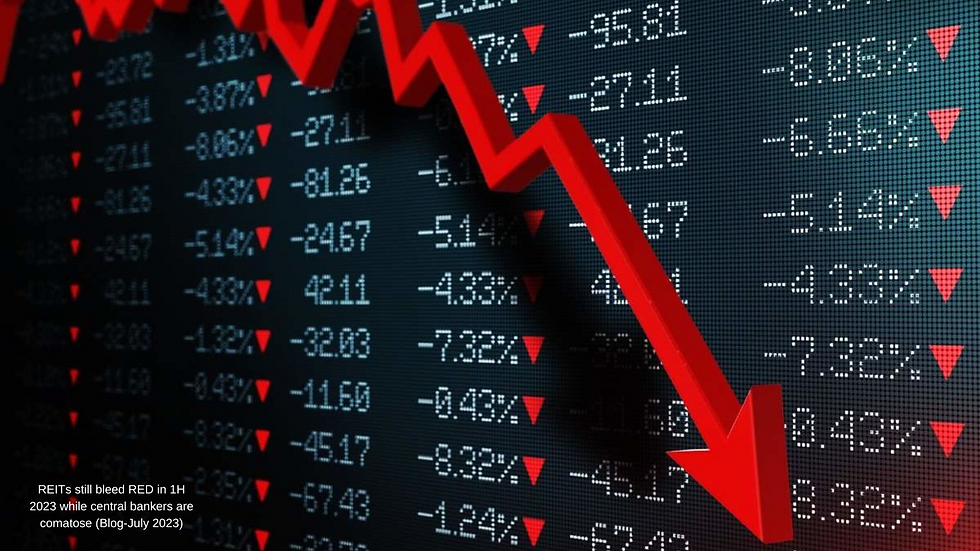PROFITING FROM HIGH DIVIDEND STOCKS IN 2014
- by Gabriel Yap

- Nov 18, 2017
- 4 min read
04/2014-
2013 ended flat-faced for most investors. The FTSTI surged to 3,454, only to crash on 22nd May 2013 after the US Federal Reserve warned of tapering of its mortgage purchases. After hitting a bottom at 3.040 on Sep 2013, the FTSTI has flirted with the key resistance of 3,190 with key support of 3.060. It has been a long long trading narrow range of 130 points for 9 months.

This long tight trading range of 130 points was broken on the downside and hit a low of 2,960 on 5th February 2014 as the market became embroiled with Emerging Market fears when Argentina devalued its currency and political problems hightened in Thailand and Ukraine.
In retrospective, 2013 continued to vindicate my life-long recommendation to continue to adopt a High Dividend Stock Investing strategy (HDS), which have continued to outperform the FTSTI substantially.
The list of 13 HDS per attached below which I focus on, have outperformed the FTSTI by a huge 100% and I do expect this to continue in 2014.

Investing in a portfolio of HDS kills 2 birds with one stone – it allows the investor to ride on the compounding of growth and income while reducing the risk as most of the HDS are in traditionally steady businesses, short of what most analysts would have term them as “cash-cows”. In fact if one studies the free cash flows, FCF or such companies, you would not be surprised to find that most of them in fact are more than “cash-cows” as most HDS would be generating FCF way above the normal business needs for normal capital expenditure, normal expansion and capital maintenance allowances. The excess, is then, paid as dividends to shareholders.
Essentially, a company’s cashflow is essentially utilized for:-
Capital Expenditure to maintain the level of operating efficiency
Pay off debts n thereby lower its gearing
For payment as dividends to shareholders
For profit retention
For example, the Singapore telecom sector, in my opinion fits, snuggly into this description and has continued to be a key holding in many of my clients and my investment portfolio.
The telecom industry is marked by high barriers to entry as it entail high fixed costs investments for data cables, sub-sea cables, licences fees, base station costs etc
If one studies the FCF and Capex carefully for the past decade, it becomes clear that capex requirements for 4G/LTE spectrums are far lower than the earlier 2G/2.5G spectrums despite better pricing power commanded by the telcos.
The other hallmark that I find true in profitable investing is – Investing for dividend returns are far safer than investing for capital gains. In fact, a study into local stocks on our local bourse revealed that of the Total Returns from Stocks in the past decade, 48% was generated from dividends as opposed to capital gains. I would expect this ratio to increase in the coming decade.
Take ## First Reit as an illustration. (## I have been a shareholder of First Reit since IPO)
First Reit owns hospitals and nursing homes in Singapore and Indonesia. It IPO in December 2006 at 71 cts with only 4 assets worth a total of $257 million comprising Siloam Lippo Village, Surubaya, Kebon Juruk and Aryaduta hotel country club.
Over the last 7 years, it added more hospitals and expanded into South Korea. It currently owns a total of 14 hospitals and nursing homes worth a total of $1 billion. Thus, its no. of hospitals/nursing homes has increased by more than 350% while in value, it has climbed 400%!
It is run by the REIT manager, Bowsprit Capital, led by the affable Dr Ronnie Tan who was instrumental in building up Parkway Holdings in the 1990s into a well-reknown healthcare player.
Along with the growth of the REIT, shareholders benefited tremendously – the REIT returned a total of 50.75 cts in DPU from 2007 to 2013.

It had a 5 for 4 rights issue in 2009 at 50 cts. Thus, based on its recent price of $1.04, the average unit price works out to (71x4 + 50x5)/9 = 53.77 cts for the IPO investor who subscribe to its Rights issue.
Thus, IPO investors would have gotten back 46.84 cts in dividends while sitting on a healthy capital gain of $1.04 - $0.5377 = 50.23 cts over 7 years! This is a capital gain of almost 100%!
Including total dividends received todate of 50.75 cts, an IPO investor would be sitting on a total return of (50.75 + 50.23)/53.77 = 187.8%!! Kudos and do find me another investment that can deliver such safe and steady return!!
Buried within these figures are some key qualitative points –
If you invest for dividends, you will still feel psychologically safer as the REIT continued to pay you dividends of 7.62 cts and 7.62 cts respectively in the Global Financial Crisis years of 2008 and 2009 respectively. This would have allowed you to invest in other stocks that probably got whacked badly – therein, you create an investment opportunity to buy at fire-sale prices for yourself.
You grow in line with the growth of the company assets which are well managed within a gearing of 32%.
As First Reit revenue structure is based on 10 + 10 years renewal or 10 + 5 years renewal lease structure, your DPU or income is unlikely to vary much on a year-on-year basis. This would have meant lower risk for your overall investment portfolio.
Thus when Warren Buffet tells you to “Be Greedy when others are fearful”, I would tell you - “Be steady and invest in fire-sale HDS when others are fearful”.
Happy Investing.




Comments